International Relations of Africa II (Online Bachelor of Science)
International Relations of Africa II (Bachelor of Science in Inter-African Business, e-learning)
| Bachelor of Science in Inter-African Business |
Subject - “International Relations of Africa II” (5 ECTS) - Online Bachelor of Science in Inter-African Business (Sixth semester).
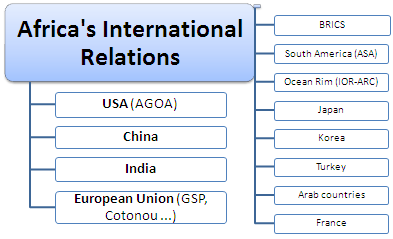

Syllabus of the Program: Africa-Arab Countries Cooperation
- Introduction to the Afro-Arab Cooperation
- Afro-Arab Development Forum
- Third Afro-Arab Summit
- Afro-Arab Preferential Trade Area
- Bodies of the Afro-Arab Cooperation
- Afro-Arab Institute for Culture and Strategic Studies
- International Trade between the African Countries and the Arab countries
Arab Bank for Economic Development in Africa (BADEA).
- Introduction to the Arab Bank for Economic Development in Africa
- Structure of the BADEA
- Projects financed by the Arab Bank for Economic Development in Africa
- Seventh Five-Year Plan (2015-2019) of the BADEA
- BADEA Export Financing Scheme
- Arab and African Businesswoman Forum
Objectives of the Program “Africa-Arab Countries Cooperation”:
- To understand the objectives of the Africa-Arab Countries Cooperation
- To analyze the areas of cooperation between Africa and the Arab countries
- To analyze the economic relations between the African Countries and the Arab countries
- To understand the role of the Arab Bank for Economic Development in Africa (BADEA)
- To know the BADEA Export Financing Scheme
- To understand the concept of “Afro-Arab Preferential Trade Area”
Syllabus of the Program: Organization of Islamic Cooperation (OIC).
- Introduction to the Organization of Islamic Cooperation (OIC)
- The Ummah
- Subsidiary Organs of the OIC
- Committee for Economic Cooperation (OIC)
- Economic Centre for Islamic Countries
- Center for Research on Islamic history, art and culture
- Islamic University of Technology
- Islamic Centre for Development of Trade
- Islamic Fiqh Academy
- Islamic Solidarity Fund and the Waqf
- Trade Preferential System between the member states of the OIC
- Institutions and specialized agencies of the Islamic Cooperation
- Islamic Development Bank (BID)
- International Islamic Agency of Press
- Islamic Chamber of Commerce and Industry
- Economic Report on the countries of the OIC
- Cairo Declaration on Human Rights in Islam
- Chart of the OIC
Standing Committee for Economic and Commercial Cooperation of the OIC (COMCEC).
- Introduction to the Standing Committee for Economic and Commercial Cooperation of the OIC
- Objectives of the Standing Committee for Economic and Commercial Cooperation
- Areas of cooperation of the Standing Committee for Economic and Commercial Cooperation of the OIC
- International Trade
- Transport
- Agriculture
- Tourism
- Financial cooperation
- Poverty reduction
- Private sector cooperation
- International Trade between the members of the OIC and the World
Statistical, Economic and Social Research and Training Centre for Islamic Countries (SESRIC).
- Introduction to the Statistical, Economic and Social Research and Training Centre for Islamic Countries
- Department of economic and social research
- Economic Report on the member countries of the OIC
- Production, growth and employment
- Intra-OIC International Trade
- FDI
- Financial sector
- Economic Troubles of the Least-Developed and Land-Locked OIC Countries of the OIC
- Department of statistics and information
- Socio-economic statistics of slamic countries;
- BASEIND Database
- Statistical yearbook of the member countries of the OIC
- Economic prospects of the member countries of the OIC
Islamic Centre for Development of Trade (CIDC).
- Introduction to the Islamic Centre for Development of Trade
- Objectives of the Islamic Centre for Development of Trade
- International Trade and investments promotion
- Trends in international trade of the member states of the OIC
Trade Preferential System (SPC) of the OIC
- Introduction to the Trade Preferential System of the OIC
- Framework Agreement on the Trade Preferential System of the OIC
- Protocol on the Preferential Tariff Scheme (PRETAS)
- Rules of origin
Islamic Chamber of Commerce and Industry.
- Introduction to the Islamic Chamber of Commerce and Industry (CICI)
- Objectives of the Islamic Chamber of Commerce and Industry
- Islamic Finance: Opportunities, Challenges, and Policy Options
- Waqf Funds
- Sukukh markets
Objectives of the Program “Organization of Islamic Cooperation (OIC)”:
- To understand the objectives and the areas of cooperation of the OIC
- To understand the relationship between the Organization of Islamic Cooperation and the Ummah
- To know the institutions related to the Organization of Islamic Cooperation: the Standing Committee for Economic and Commercial Cooperation, the SESRIC.
- To understand the role of the Islamic Centre for Development of Trade (intra-Arab International Trade promotion) and the Islamic Chamber of Commerce and Industry
- To analyze the Trade Preferential System between the member states of the OIC (PRETAS, the rules of origin...)
Syllabus of the Program: Islamic Development Bank
- Introduction to the Islamic Development Bank (IDB)
- Vision 1440H of the IsDB
- Islamic Dinar (Unit of account)
- Principles of the Islamic Economy
- Strategic framework of the IsDB
- Finance and projects cycle of the Bank
- Financing modes of the Bank. Istisna'a
- Sharia (Islamic Law)
- Islamic Corporation for Insurance of Investments and Export Credits
- Islamic Corporation for the Development of the Private Sector
- Foreign Trade finance
- Export Financing scheme of the IsDB
Objectives of the Program “Islamic Development Bank”:
- To understand the objectives, structure and functions of the IsDB
- To identify the areas of cooperation of the IsDB
- To know the role of the Bank in the Sharia promotion, economy and Islamic finance
- To analyze the methods of financing of the Islamic Development Bank and the solutions for financing exports of the member countries
- To evaluate the funds and financial instruments of the IsDB
- To know the related institutions: BADEA, the Islamic Corporation for Insurance of Investments and Export Credits
- To understand the projects cycle of the Bank
Syllabus of the Program: Arab Development Funds:
- Introduction to the Arab Official Development Assistance
- Arab Development Funds
- Organizations related to Arabic Trade promotion
Arab Fund for Economic and Social Development.
- Introduction to the Arab Fund for Economic and Social Development
- Objectives and projects financed by Arab Fund
- Beneficiary countries of the Arab Fund for Economic and Social Development
Arab Monetary Fund.
- Introduction to the Arab Monetary Fund (Emirates)
- International Trade promotion between the Muslim Countries
Arab Trade Financing Programme
- Introduction to the Arab Trade Financing Programme (Emirates)
- Intra-Arab Trade Promotion
- Support for the Arab Free Trade Zone
- Financing tools in accordance with the Islamic Sharia
OPEC Fund for International Development.
- Introduction to the Fund for International Development of the Organization of Petroleum Exporting Countries
- Funds to boost South-South solidarity and for developing economies promotion
Abu Dhabi Fund for Development.
- Introduction to the Abu Dhabi Fund for Development
- Development Projects Financing in the Islamic Countries
Saudi Fund for Development.
- Introduction to Saudi Fund for Development
- Saudi Fund's role in promoting the exports of non-petroleum products in the Muslim Countries
The main objective of the Program “Arab Development Funds” is to offer a global and practical vision on...
- Arab Official Development Assistance (AODA) and the largest Arab donors
- The principal beneficiaries of Arab Official Development Assistance
- The characteristics of the Arab Development Funds
Syllabus of the Program: Summit South America-Arab Countries (ASPA)
- Introduction to the Summit South America-Arab Countries
- Structure and organization chart of the ASPA
- III Summit ASPA
- Lima, Brasilia and Doha Declarations
- The Sixth meeting of the Council of officials of the ASPA
- The UNASUR and the Arab League
Objectives of the Program “Summit South America-Arab Countries (ASPA)”:
- To understand the objectives of the Summit South America-Arab Countries
- To understand the functioning of the ASPA
- To analyze the areas of cooperation of the Summit South America-Arab Countries
Syllabus of the Program: Asia-Middle East Dialogue (AMED).
- Introduction to Asia-Middle East Dialogue (AMED)
- AMED Member countries
- Objectives of the Asia-Middle East Dialogue
- Working Groups of the AMED
- III Forum of the Asia-Middle East Dialogue (AMED III)
Objectives of the Program “Asia-Middle East Dialogue (AMED)”:
- To understand the objectives of the Asia-Middle East Dialogue
- To evaluate the role of the AMED Working Groups
- To analyze the economic profile of the member countries of the Asia-Middle East Dialogue
Syllabus of the Program: Agadir Agreement. Arab Mediterranean Free Trade Agreement.
- Introduction to the Arab Mediterranean Free Trade Agreement (Agadir Agreement)
- Member countries of the Agadir Agreement: Egypt, Morocco, Tunisia, and Jordan
- Role of the EU in the Agadir Agreement
- Technical unit of the Agadir Agreement
- Barcelona Process
- Agadir Agreement and the Pan-Euro-Mediterranean System of accumulation of Origin
- International Trade between the member countries of the Agadir Agreement
- International Trade with the EU
Syllabus of the Program: Cooperation Framework for Turkey-Africa Partnership.
- Introduction to the Africa-Turkey Association
- New model of partnership to enhance a sustainable development and integration
- Cooperation Framework for the Turkey-Africa Association
- Africa-Turkey Summit
- Istanbul Declaration on Turkey-Africa Partnership: Cooperation and Solidarity for a Common Future
- International Trade Africa-Turkey
Objectives of the Program “Africa-Turkey Association”:
- To understand the objectives of the Africa-Turkey Association
- To understand the concept of “Turkey as an Afro-Eurasian country ”
- To analyze the areas of cooperation between Africa and Turkey
- To analyze the international trade between the African Countries and Turkey
Syllabus of the Program: Africa-BRICS Cooperation
- Introduction to Africa-BRICS Cooperation (Brazil, Russia, India, China, South Africa)
- Trade relations between the African Countries and the BRICS
- International Trade Africa-BRICS Countries
- Opportunities and challenges for the Africa-BRICS Cooperation
- Foreign Direct Investment Africa-BRICS
- Trends of the Cooperation Africa-BRICS
- Implications for growth, employment, and structural transformation
Objectives of the Program “Africa-BRICS Cooperation”:
- To understand the objectives and functions of the Africa-BRICS Cooperation
- To analyze the international trade and investments between Africa and the BRICS Countries
- To evaluate the trends of Africa-BRICS Cooperation
Syllabus of the Program: TNew Asian-African Strategic Partnership (NAASP).
- Introduction to the New Asian-African Strategic Partnership
- Asia-Africa Summit
- International Trade Asia-Africa
- Afro-Asian Conference (Conference of Bandung)
- Declaration on the New Asian-African Strategic Partnership
Objectives of the Program “New Asian-African Strategic Partnership”:
- To understand the objectives of the New Asian-African Strategic Partnership
- To evaluate the advantages for the African Countries
- To know the pillars of the Afro-Asian cooperation
- To analyze the international trade between the Asian and the African Countries
Syllabus of the Program: South Korea-Africa Economic Cooperation Conference (KOAFEC).
- Introduction to the South Korea-Africa Economic Cooperation Conference
- Organization of the South Korea-Africa Economic Cooperation Conference
- The main areas of cooperation between Africa and South Korea
- Ministerial Conference Joint Declaration
- Joint Declaration of the South Korea-Africa Economic Cooperation
Objectives of the Program “South Korea-Africa Economic Cooperation Conference”:
- To understand the objectives of the Association Africa-South Korea
- To analyze the areas of cooperation
- To analyze the international trade between Africa and South Korea
Syllabus of the Program: Tokyo International Conference on African Development.
- Introduction to process TICAD (Japan-Africa)
- V Tokyo International Conference on African Development (TICAD V)
- Yokohama Declaration and Action Plan
- Trade relations Japan-Africa
Objectives of the Program “Tokyo International Conference on African Development”:
- To understand the objectives of the process TICAD between Africa and Japan
- To know the implications of the Yokohama Action Plan
- To analyze the international trade between the African Countries and Japan
Syllabus of the Program: Indian-Ocean Rim Association (IORA).
- Introduction to the Indian-Ocean Rim Association (IORA)
- Objectives of the Indian-Ocean Rim Association
- Countries of the IORA
- Structure of the Indian-Ocean Rim Association
- Specialized agencies of the Indian-Ocean Rim Association
- Working groups on Trade and investments
- Priority areas;
- Trade and Investment Facilitations
- Preferential Trade Agreement
- Fishing
- Tourism
- Gender
- Action Plan of the Indian-Ocean Rim Association
- Projects of the Indian-Ocean Rim Association (IORA)
- Chart of the Indian-Ocean Rim Association
Objectives of the Program “Indian-Ocean Rim Association (IORA)”:
- To understand the objectives, structure and institutions of the Indian-Ocean Rim Association
- To know the role of the IORA Working groups IORA on Trade and investments
- To evaluate the advantages for the IORA member countries and the areas of cooperation (técnica, economic...)
The African member states of the Indian-Ocean Rim Association (IORA) are South Africa, the Comoros, Kenya, Madagascar, Mauritius, Mozambique, the Seychelles, Tanzania.
Syllabus of the Program - Africa-South America Summit (ASA).
- Introduction to Africa-South America Summit (ASA)
- Third Africa-South America Summit
- Infrastructures, energy and transport
- UNASUR and the African Union (UA)
- Malabo Declaration
- Implementation Plan of the Africa-South America Summit
- Declaration of Abuja and new Esparta (*)
- Marrakech Action Plan of (*)
Objectives of the Program “Africa-South America Summit (ASA)”:
- To understand the objectives of the Africa-South America Summit
- To know the implementation plan of the ASA
- To analyze the economic relations between the African and South American countries
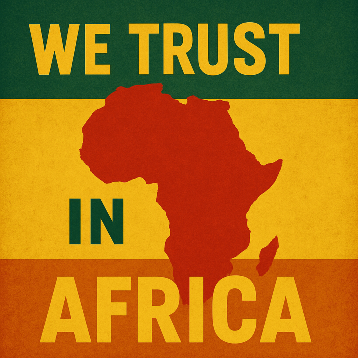
- ECTS = European Transfer and Accumulation System
- CECT = Credit of Capitalisable and Transferable Evaluation (CAMES)
Samples: International Relations of Africa II (Bachelor of Science in Inter-African Business, e-learning, Sixth semester).
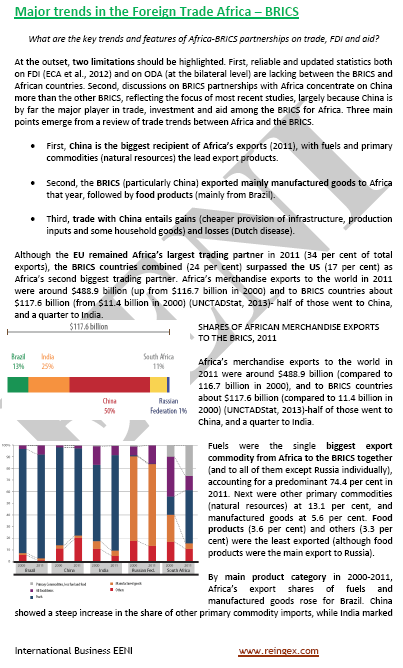
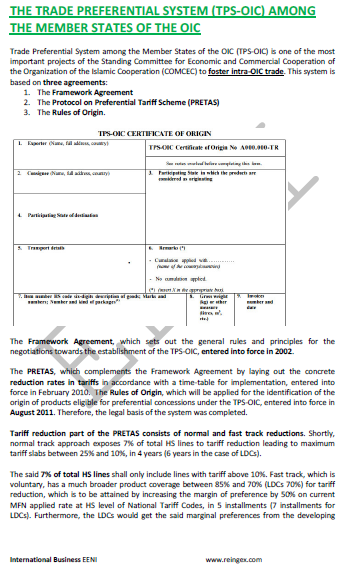


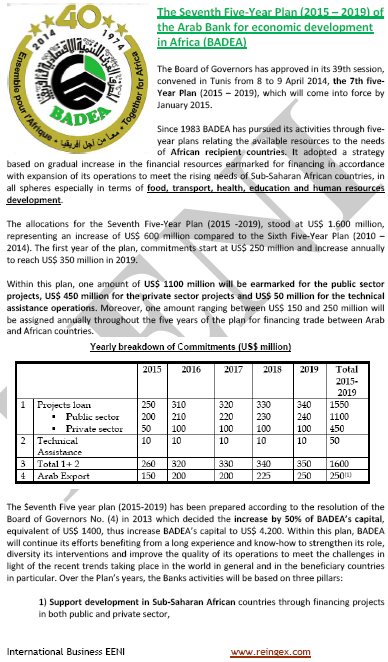
Language of the subject “International Relations of Africa II” of the Bachelor of Science in Inter-African Business taught by EENI Global Business School (Sixth semester):  or
or  EENI
EENI  EENI
EENI  EENI.
EENI.
(c) EENI Global Business School (1995-2024)
We do not use cookies
Top of this page

